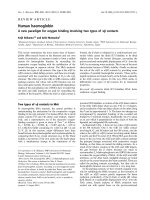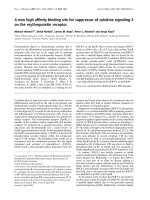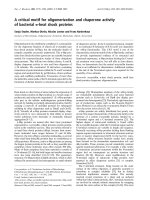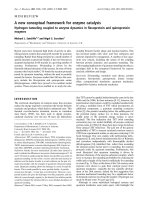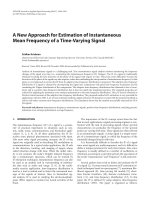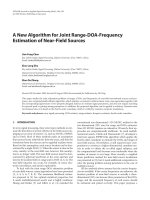Báo cáo y học: "A new era for proteomics research" pptx
Bạn đang xem bản rút gọn của tài liệu. Xem và tải ngay bản đầy đủ của tài liệu tại đây (38.9 KB, 2 trang )
Genome
BBiioollooggyy
2008,
99::
325
Meeting report
AA nneeww eerraa ffoorr pprrootteeoommiiccss rreesseeaarrcchh??
Mathias Uhlen
Address: School of Biotechnology, AlbaNova University Center, Royal Institute of Technology (KTH), Stockholm SE-10691, Sweden.
Email:
Published: 4 November 2008
Genome
BBiioollooggyy
2008,
99::
325 (doi:10.1186/gb-2008-9-11-325)
The electronic version of this article is the complete one and can be
found online at />© 2008 BioMed Central Ltd
A report of the 7th Annual Human Proteome Organization
(HUPO) Conference, Amsterdam, the Netherlands, 16-20
August 2008.
The human genome sequence provided information on the
protein-encoding genes that are expressed in the hundreds of
cell types that make up the human body. The next step
forward is to use the information from genomics research for
a systematic study of the human proteome. At the recent
Human Proteome Organization (HUPO) conference in
Amsterdam, various approaches to such studies were dis-
cussed. Topics covered the use of proteomics to study biology
in humans and model organisms, including investigations
aimed at increasing the understanding of cellular pathways,
the biology of stem cells, and subcellular organization.
The state of the art in mass spectrometry was addressed in
several keynote lectures. Refined instrumentation and more
advanced software for analysis means that whole-proteome
coverage for model organisms in a single experiment can
now be envisaged and relatively low-abundance
mammalian proteins can be detected. Ruedi Aebersold
(ETH, Zurich, Switzerland and ISB, Seattle, USA) described
the identification of ‘proteotypic peptides’ - protein
fragments that are detectable in mass spectrometry - and
pointed out that a vision for the future might be to identify
and publish such peptides for all human proteins and to
make these publicly available through web portals such as
the Peptide Atlas [www.peptideatlas.org]. Matthias Mann
(Max Planck Institute of Biochemistry, Martinsried,
Germany) focused on the advantages of using stable
isotopes to achieve higher accuracy in quantitative
measurements of proteins. He described the use of SILAC
(stable isotope labeling with amino acids in cell culture) for
the study of proteins in cell lines and model organisms such
as rat and mouse. By combining kinase-specific affinity
purification and quantitative mass spectrometry, more than
1,000 phosphorylation sites on human protein kinases were
identified, and interestingly, more than half of these were
upregulated during mitosis in human cancer cells.
AAnn aattllaass ffoorr hhuummaann pprrootteeiinn ddiissttrriibbuuttiioonn
The use of antibodies and other affinity reagents to study the
human proteome was the topic of many talks. Emma Lundberg
(Royal Institute of Technology, Stockholm, Sweden) des-
cribed the use of antibodies from the Human Protein Atlas
program [www.proteinatlas.org] to explore the subcellular
localization of proteins in three human cell lines of glioma,
epithelial and mesenchymal origin. An analysis of 2,000
proteins suggested that approximately one-third were
localized mainly to the nucleus. Version 4.0 of the Human
Protein Atlas was launched at the conference. This
compendium of protein distribution now contains data from
experiments with 6,000 antibodies and more than 5 million
high-resolution images, double the content of the previous
year. Profiles showing a protein’s distribution in cells, tissues
and organs cover more than 5,000 genes, approximately
25% of human protein-coding genes.
Erik Björling (Royal Institute of Technology, Stockholm,
Sweden) presented a new gene-centric organization of the
atlas, which now allows advanced queries involving protein
classes, chromosomal location and protein profiles in normal
and cancer tissues. Fredrik Ponten (Uppsala University,
Sweden) described the use of the portal as a discovery tool
for potential biomarkers in the fields of breast, colorectal,
prostate and lung cancer. He presented several examples
with prognostic value, such as the putative human trans-
cription factor SATB2 for the prediction of outcome for
colorectal cancer patients, as evaluated by subsequent
analysis using validation cohorts containing many hundreds
of disease-specific samples from patients.
PPrrootteeoommee bbiioollooggyy aanndd iinntteerraaccttiioonn aannaallyyssiiss
It is evident that human biology depends on precise regu-
lation of protein concentrations in space and time and
intricate interactions between different protein isoforms to
form stable complexes and transient interaction networks.
This topic was addressed by Anne-Claude Gavin (EMBL,
Heidelberg, Germany), who reviewed progress in the global
analysis of biomolecular interactions. Genome-wide scans in
model organisms have led to network maps of general rele-
vance for eukaryotic organisms. The generation of compre-
hensive maps involving specific pathways can be used to
identify potential therapeutic targets. Gavin pointed out that
one of the challenges for the future is to adapt quantitative
biochemical interaction analysis for proteome-wide efforts.
Tony Pawson (University of Toronto, Canada) is using a
combination of classical cell biology techniques with quanti-
tative mass spectrometry to study signaling pathways. In a
study of the formation of tight junctions in kidney cells, he
has found that the protein phosphatase PP1alpha binds to
multiple sites on the Par-3 protein, regulating the binding of
other proteins. The results suggest that Par-3 acts as a
scaffold for both serine/threonine kinases and PP1 phos-
phatase. Pawson’s talk provided a good example of how the
new generation of quantitative proteomics platforms can be
used to provide detailed analysis of cell signaling based on
temporal and spatial proteomics. Hans Clevers (Hubrecht
Laboratory, Utrecht, the Netherlands) described a detailed
analysis of the stem cells of the intestinal epithelium using a
combination of molecular biology and proteomics. The
intestinal epithelium is one of the most proliferative tissues
in humans, making the intestinal crypt an interesting model
for studies of adult stem cell biology. Clevers described the
unique role of the LGR5 protein expressed specifically in the
intestinal stem cells at the crypt bottom, based on a number
of different approaches, including knock-in mouse
experiments and antibody-based protein profiling.
OOuuttllooookk ffoorr aa HHuummaann PPrrootteeoommee PPrroojjeecctt
Amos Bairoch (Swiss Institute of Bioinformatics, Geneva,
Switzerland), whose group administrates the SwissProt/
UniProt protein database, announced that the number of
human protein-coding genes was currently estimated to be
20,400, although this number is likely to change over the
next few years. Interestingly, he reported that for almost
9,000 (44%) of these genes, there is still no experimental
information about the proteins they encode. This empha-
sizes the need for a systematic effort to characterize human
proteins to leverage information from the genome project
and to form a basis for further studies. At the conference, the
possible launch of a Human Proteome Project to syste-
matically map the proteome was discussed with represen-
tatives from funding agencies from Europe, USA, Canada
and Asia. John Bergeron (McGill University, Montreal,
Canada) proposed a gene-centric approach based on three
technology platforms (mass spectrometry, antibodies and
interaction analysis) to characterize at least one represen-
tative protein variant from every gene locus. Several
participants pointed out the difficulty of a gene-centric
approach for mass spectrometry, whereas such an approach
is more feasible for antibody- and interaction-based analysis.
The shortcomings of previous systematic proteomics efforts
were brought up, emphasizing the need for increased
precision of protein identification by mass spectrometry.
Representatives of several funding agencies pointed out the
importance of focused pilot projects to show the feasibility of
the different parts of the effort, and emphasized the need for
clear end-points and international coordination.
The conference demonstrated that proteomics research has
entered a new era of biology-driven applications, with
studies of signal pathways and protein profiles in various
cells and tissues based on advances in the use of proteomics
tools. The rapid development of mass-spectrometry based,
immuno-based and gene-tagging technologies has opened
up the possibility of whole-proteome analysis. The challenge
for the proteomics community now is to show how the
human proteome can be experimentally annotated, and to
deliver a human proteome ‘parts-list’ with data on localiza-
tion and function within a reasonable time-frame. Such a
list, with its accompanying resources of protein-specific
probes (antibodies), proteotypic peptides and cDNA clones,
would provide a valuable asset for hypothesis-driven research
into human biology and disease. Such efforts will no doubt
be discussed at the next HUPO conference, to be held in
Toronto, Canada, in September 2009.
/>Genome
BBiioollooggyy
2008, Volume 9, Issue 11, Article 325 Uhlen 325.2
Genome
BBiioollooggyy
2008,
99::
325

